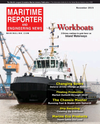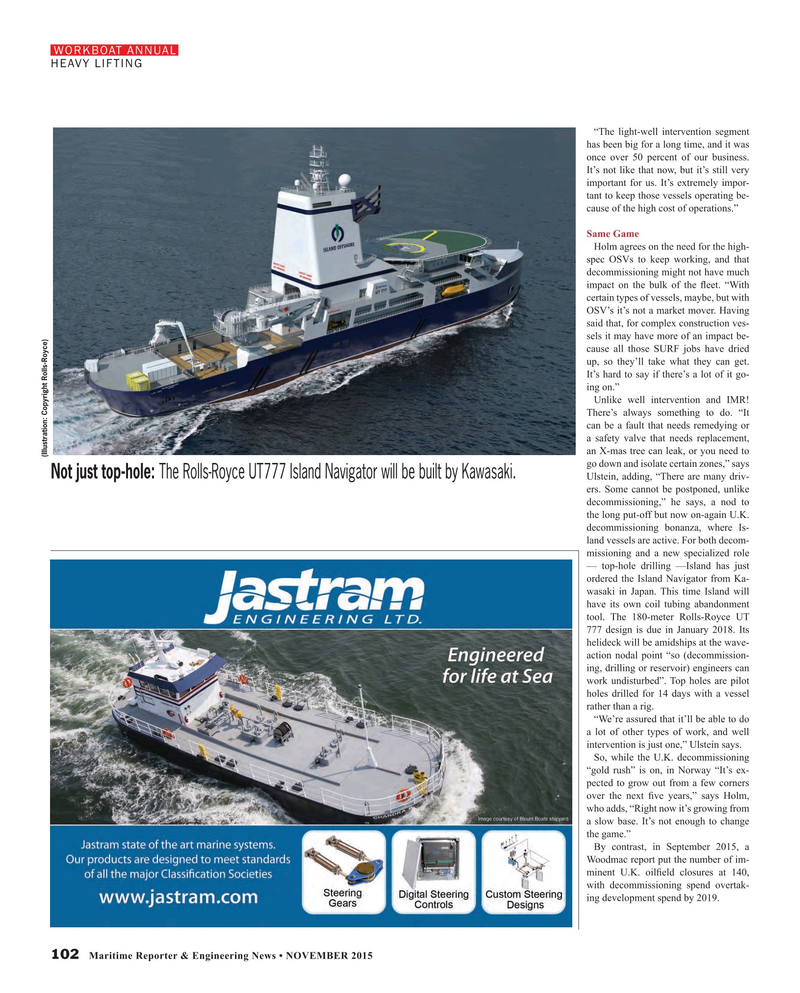
Page 102: of Maritime Reporter Magazine (November 2015)
Workboat Edition
Read this page in Pdf, Flash or Html5 edition of November 2015 Maritime Reporter Magazine
WORKBOAT ANNUAL
HEAVY LIFTING “The light-well intervention segment has been big for a long time, and it was once over 50 percent of our business.
It’s not like that now, but it’s still very important for us. It’s extremely impor- tant to keep those vessels operating be- cause of the high cost of operations.”
Same Game
Holm agrees on the need for the high- spec OSVs to keep working, and that decommissioning might not have much impact on the bulk of the ? eet. “With certain types of vessels, maybe, but with
OSV’s it’s not a market mover. Having said that, for complex construction ves- sels it may have more of an impact be- cause all those SURF jobs have dried up, so they’ll take what they can get.
It’s hard to say if there’s a lot of it go- ing on.”
Unlike well intervention and IMR!
There’s always something to do. “It can be a fault that needs remedying or a safety valve that needs replacement, an X-mas tree can leak, or you need to (Illustration: Copyright Rolls-Royce) go down and isolate certain zones,” says
Not just top-hole: The Rolls-Royce UT777 Island Navigator will be built by Kawasaki.
Ulstein, adding, “There are many driv- ers. Some cannot be postponed, unlike decommissioning,” he says, a nod to the long put-off but now on-again U.K. decommissioning bonanza, where Is- land vessels are active. For both decom- missioning and a new specialized role — top-hole drilling —Island has just ordered the Island Navigator from Ka- wasaki in Japan. This time Island will have its own coil tubing abandonment tool. The 180-meter Rolls-Royce UT 777 design is due in January 2018. Its helideck will be amidships at the wave- action nodal point “so (decommission- ing, drilling or reservoir) engineers can work undisturbed”. Top holes are pilot holes drilled for 14 days with a vessel rather than a rig.
“We’re assured that it’ll be able to do a lot of other types of work, and well intervention is just one,” Ulstein says.
So, while the U.K. decommissioning “gold rush” is on, in Norway “It’s ex- pected to grow out from a few corners over the next ? ve years,” says Holm, who adds, “Right now it’s growing from a slow base. It’s not enough to change the game.”
By contrast, in September 2015, a
Woodmac report put the number of im- minent U.K. oil? eld closures at 140, with decommissioning spend overtak- ing development spend by 2019. 102 Maritime Reporter & Engineering News • NOVEMBER 2015
MR #11 (98-105).indd 102 11/2/2015 3:25:14 PM

 101
101

 103
103
